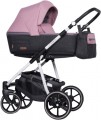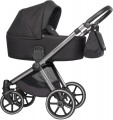Add to comparison |  |  |
|---|---|---|
| RIKO Swift Natural 2 in 1 | RIKO Qubus 2 in 1 | |
| Outdated Product | Outdated Product | |
| TOP sellers | ||
| Design | universal | universal |
| Type | single | single |
| Folding system | booklike type | booklike type |
Carrycot and walking unit | ||
| Backrest tilt adjustment | ||
| Adjustable footrest | ||
| Fastening in the direction/against the movement | ||
| Bumper bar | ||
| Crotch strap | ||
| Viewing window | ||
| Harness type | 5-point | 5-point |
Frame and chassis | ||
| Depreciation | spring | spring |
| Number of wheels | 4 | 4 |
| Carrycot installation | ||
| Car seat installation | ||
| Handle type | classic | classic |
| Handle height adjustment | + | + |
| Frame material | aluminium | aluminium |
Wheels | ||
| Swivel wheels | ||
| Lockable front wheels | ||
| Wheels | rubber solid | rubber solid /polyurethane/ |
| Wheels rim | plastic | plastic |
| Front wheels diameter | 24 cm | 24 cm |
| Rear wheels diameter | 29 cm | 29 cm |
Delivery set | ||
| In box | seat unit carrycot foot cover rain cover mosquito net bag / backpack for things shopping basket | seat unit carrycot foot cover rain cover mosquito net bag / backpack for things shopping basket |
General | ||
| Dimensions (unfolded) (LxWxH) | 103x56x111 cm | 78x56x101 cm |
| Chassis width | 56 cm | 56 cm |
| Dimensions (folded) (LxWxH) | 78x56x36 cm | 63x56x47 cm |
| Seat width | 33 cm | 31 cm |
| Carrycot weight | 4.8 kg | 4.9 kg |
| Walking unit weight | 5.1 kg | 5.9 kg |
| Chassis weight | 8.8 kg | 8.9 kg |
| Weight (complete) | 13.9 kg | 14.8 kg |
| Country of origin | Poland | Poland |
| Added to E-Catalog | june 2019 | may 2019 |